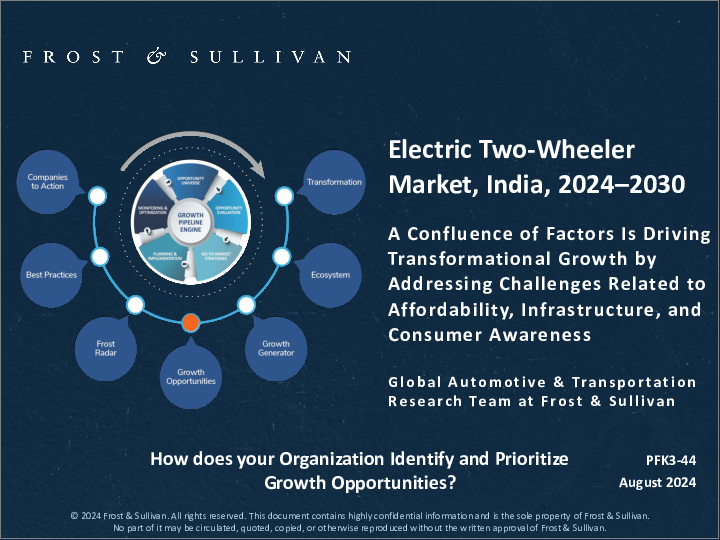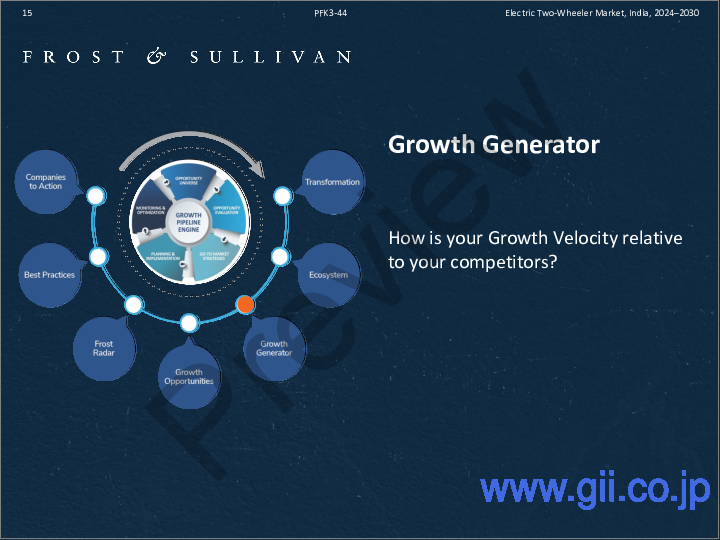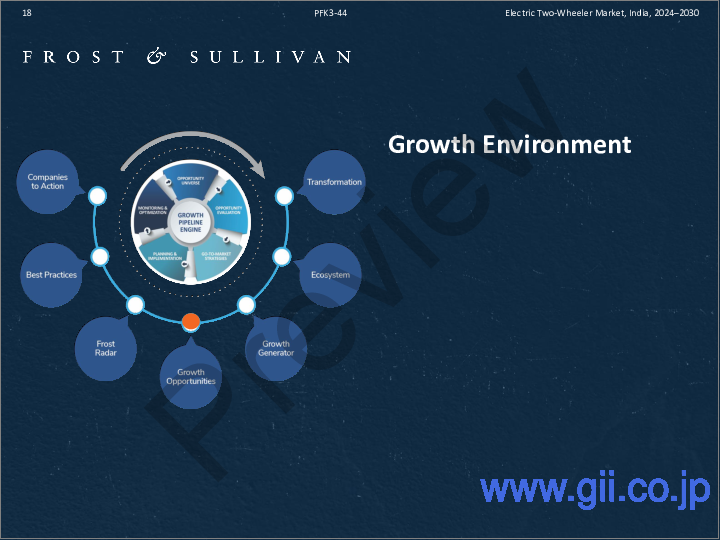|
|
市場調査レポート
商品コード
1559500
インドの電動二輪車(e2W)市場:予測と成長機会、2024~2030年Indian Electric Two-Wheeler (e2W) Market, Forecast and Growth Opportunities, 2024-2030 |
||||||
|
|||||||
| インドの電動二輪車(e2W)市場:予測と成長機会、2024~2030年 |
|
出版日: 2024年08月26日
発行: Frost & Sullivan
ページ情報: 英文 107 Pages
納期: 即日から翌営業日
|
- 全表示
- 概要
- 目次
手頃な価格、インフラ、消費者意識に関する課題に対処することで、様々な要因が重なり合い、変革的な成長を促しています。
インドの電動二輪車(e2W)市場は、過去5年間で驚異的な成長を遂げました。e2Wに対する補助金や税制優遇措置など、政府の政策イニシアチブは購入意欲を刺激してきました。しかし、最近の政策変更により、市場は減速しています。しかし、政府は、コスト削減により補助金への依存度を下げ、自立したEVエコシステムを育成することを目指しており、また、進歩や需要の高まりを利用できる投資家にとっては長期的なチャンスでもあります。
既存の二輪車OEMがe2W新規参入企業の競争相手となり、選択肢の幅が広がり、技術進歩が早まる可能性のあるダイナミックな市場を形成しています。
インドのEV充電インフラは発展を続けており、政府と民間企業は充電ネットワークの拡大に投資しています。
本調査では、インドのe2W市場を分析し、投資を誘致している主要プレーヤー、主なビジネスモデル、政府政策の変化の影響、過去数年間の市場シェアの推移とその理由、利害関係者の戦略、成長機会などについて考察します。
調査ハイライト
インドのe2W市場販売台数予測
インドのe2W市場は、市場関係者による技術革新、手頃な価格、インフラ開拓に注力することで、大きな成長の可能性を秘めています。
強固な国内サプライチェーンの構築や戦略的パートナーシップは、潜在的な混乱を緩和すると同時に、進化する市場力学に機敏に対応することが成功には不可欠です。
調査範囲
- インドのe2W市場を調査します。
- インドの主要e2W相手先商標製品メーカー(OEM)を特定・分析します。
- インドのe2W市場の重要動向を把握します。
- インドのe2W市場で投資を誘致している重要なプレーヤーを把握します。
- タイプ別にOEMを特定し分析します。
- インドのe2W市場における3つの主要成長機会を特定します。
- インドのe2Wの投資、政府支援、スタートアップのシナリオを理解します。
- インドのe2W市場における主なビジネスモデルを分析します。
- e2Wバッテリースワップ技術、e2Wモーター製造、バッテリーセルサプライヤー、充電インフラにおける主要プレーヤーを分析します。
- 2025~2030年度までのインドのe2W販売台数を予測します。
調査範囲
対象地域
インド
調査期間
2019~2030年度
基準年
2024年度
予測期間
2025~2030年度
通貨単位
米国ドル
インドのe2W分析セグメンテーションの焦点と定義
電動モペッド(eMoped)
- eMopedはL1e-B車のカテゴリーに属します。
- これらのe2Wのモーター出力は4キロワット(kW)未満、最高速度は時速45km未満で、50立方メートル未満の内燃機関(ICE)2Wに相当します。
電動スクーター(eスクーター)
- eスクーターはL3e-A1カテゴリーに分類されます。
- モーター出力が4kW~11kWのe2W。
電動二輪車(eモーターサイクル)
- eモーターサイクルは、L3e-A2およびL3e-A3カテゴリーに分類されます。
- これらのe2Wのモーター出力は4kWを超えます。
インドのe2W市場の主な競合企業
- Ola Electric Technologies Pvt Ltd
- TVS Motor Company Ltd
- Ather Energy Pvt Ltd
- Bajaj Auto Ltd
- Greaves Electric Mobility Pvt Ltd (Ampere)
- Okinawa Autotech Pvt Ltd
- Bgauss Auto Private Limited
- Okaya Ev Pvt Ltd
- Hero Electric Vehicles Pvt. Ltd
- Hero Motocorp Ltd
- Kinetic Green Energy & Power Solutions Ltd
- Ultraviolette Automotive
- Orxa Energies
- Wardwizard Innovations & Mobility Limited
- Lectrix Ev Pvt Ltd
- Revolt Intellicorp Pvt Ltd
- Pur Energy Pvt Ltd
- Battre Electric Moblity Pvt Ltd
- Klb Komaki Pvt Ltd
- Quantum Energy Ltd.
- Twenty-two Motors Pvt Ltd
- Goreen E-mobility Pvt Ltd
- Tork Motors Pvt Ltd
- Ivoomi Innovation Pvt Ltd
- Jitendra New Ev-tech Pvt. Ltd
- Being India Energy And Technology Pvt Ltd
- River EV
- Simple Energy
インドのe2W市場の成長促進要因
政府による電気自動車(EV)政策改正の推進
投資の増加
充電インフラの整備
多様なオプションの提供
スマートフォンの普及
所有/リースオプションの利用可能性
インドのe2W市場の成長抑制要因
EVの航続距離に対する不安
高い生産コスト
現地バッテリーメーカーの不足
新規参入企業に対する販売店・代理店網の普及率の低さ
農村部での認知度の低さと道路インフラの不足
主要課題
市場概況
インドのe2W市場は活況を呈しており、2024年度の普及率は5.3%を超えます。販売台数は驚異的な伸びを示しており、高速のeスクーターが牽引役となって、よりクリーンで効率的、かつパワフルな電動オプションへの消費者シフトを示しています。
政府規制
インド政府は、FAME-IIやElectric Mobility Promotion Scheme(EMPS)2024といった、メーカーや購入者に補助金やインセンティブを提供する制度を通じて、e2Wの導入を積極的に支援しています。インド政府は、2030年までにe2Wの市場シェアを80%に拡大することを目指しています。
競合環境
Hero MotoCorp、Bajaj、TVSなどの既存プレーヤーに、Ather EnergyやOla Electricなどの新規参入プレーヤーが加わり、多様な製品を提供するダイナミックな市場が形成されています。このような競合環境は、バッテリー技術、航続距離、機能の革新を促し、消費者向けのe2Wの種類を増やすことにつながっています。
充電インフラ
充電インフラは、特にティアIIIやティアIVの都市では、e2W普及の大きなハードルとなっています。政府とSun Mobility、Battery Smart、Gogoro、Ather Gridなどの民間企業は、充電ネットワークとBattery-as-a-Service(BaaS)の拡大に投資し、e2Wエコシステムを強固なものにしています。
市場動向
組み込み型テレマティクス、リムーバブルバッテリー、急速充電、タッチスクリーンディスプレイは、インドのe2W市場で最も急速に進化している動向の一部です。これらの機能を組み合わせることで、より接続性が高く、便利でユーザーフレンドリーなe2W体験が実現し、e2Wの普及が加速し、より持続可能な未来に貢献します。
インドのe2W市場の既存のEV充電ステーション
2024年2月現在、インドには1万2,146カ所の公共の電気自動車(EV)充電ステーションがあります。
2024年におけるe2W利害関係者の戦略的重点分野
- 顧客重視戦略(ターゲットオーディエンス戦略)
- 小売戦略
- e2W市場利害関係者の価格設定とインセンティブ戦略
- 製品開発と差別化戦略
- 新たな収益源の開拓
インドのe2Wの利害関係者ビジネスモデル
- e2W販売・サービスビジネスモデル
- 充電インフラのビジネスモデル
- e2Wフリートオペレーターのビジネスモデル
目次
変貌
- なぜ成長が難しくなっているのか?
- The Strategic Imperative 8(TM)
- インドの電動二輪車(e2W)産業における3大戦略的重要事項のインパクト
エコシステム
- 分析範囲
- e2Wのセグメンテーションと定義
- 主な競合企業
成長要因
- 成長指標
- 予測の前提条件
- 調査手法
- 成長促進要因
- 成長抑制要因
成長環境
- インドのe2W市場:主要なポイント
- インドのe2W市場:スナップショット
- インドのe2W市場のロードマップ
- インドのe2Wの全体市場の魅力
- インドのe2W市場の展望
- インドのe2Wの主要パラメータと影響分析
- インドのe2W市場の主要イネーブラー
- OEM:e2Wの売上比較
- インドの主要モデルの顧客関連e2W仕様
- 主要企業の主要モデルの比較分析
- インドのe2W市場排気量と航続距離の比較
- 2024年度の売上高に基づくe2W OEMトップ:ベンチマーク
- 主要国のe2W成長率
- 主要e2W OEMとその投資計画
- 主要e2W OEMの成長と技術マトリックス
- インドのe2W OEMと新興企業の特徴マッピング
- 市場に影響を与える最近のパートナーシップ
- インドのe2W市場の展望と課題に関する分析
インドのマクロ経済概観と規制シナリオ
- 経済概要インド
- インドのPESTLE分析とe2W市場への影響
- 投資の魅力インド
- インドのEV政策ロードマップ
- 政府の新しいEV政策インド
- 主な政府規制:州別e2Wインセンティブ
- スワッピングステーション州政府の主な取り組み
- 主要州のEV政策比較
- 主要州のEV政策比較消費者インセンティブ
- 主要州のEV政策比較産業利害関係者(サプライヤー)インセンティブ
インドのe2Wの市場概要
- インドのe2W市場:概要
- インドのe2W技術動向
- インドのe2W市場主な課題
- インドのe2W市場TCO e2WとICEの比較分析
- インドのe2W市場過去の販売台数
- インドのe2W市場:過去の販売台数インドのe2W市場:予測販売台数
競合情勢分析
- インドのe2W市場の競合情勢
- e2W市場のシェア推移
- インドのレガシー2Wブランドによる投資戦略
- 海外e2Wブランドのインド進出による影響分析
- インドのe2W市場OEM販売
- インドのe2W市場OEM別市場シェア(2022年度、2023年度)
- 価格の影響分析:e2Wへの補助金削減
- 新興企業に投資する主な参加企業
- インドのe2Wエコシステムにおける主要新興企業の資金獲得(2023~2024年)
インドのe2Wエコシステム
- e2W市場のビジネスモデルキャンバス
- インドのe2W市場既存のEV充電ステーション
- インドのe2W市場バッテリー交換ソリューションの主要企業
- インドのe2W市場フリート運営事業者の抜粋
- インドのe2W市場e2Wの資金調達プレーヤー:抜粋
- インドのe2W市場e2Wコンポーネントのプレーヤー:抜粋
- インドのe2W市場バッテリーリサイクルの主なプレーヤー
2024年におけるe2W利害関係者の戦略的重点分野
- 顧客重視戦略
- 小売戦略
- e2W市場利害関係者の価格設定とインセンティブ戦略
- 製品開発と差別化戦略
- 新たな収益源の開拓
インドのe2Wの利害関係者ビジネスモデル
- e2W販売・サービスビジネスモデル
- 充電インフラビジネスモデル
- e2Wフリートオペレーターのビジネスモデル
成長機会ユニバース
- 成長機会1:EVコンポーネントの現地化
- 成長機会2:新たな収益源を生み出すための多角化
- 成長機会3:バッテリーのリサイクル
ベストプラクティスの評価
フロストレーダー
次のステップ
A Confluence of Factors Is Driving Transformational Growth by Addressing Challenges Related to Affordability, Infrastructure, and Consumer Awareness
The Indian electric two-wheeler (e2W) market has witnessed phenomenal growth over the past five years. Government policy initiatives including subsidies and tax breaks on e2Ws have incentivized purchases. However, with recent policy changes there has been a slowdown in the market, but the government aims to cultivate a self-sustaining EV ecosystem, with cost reductions leading to less reliance on subsidies, also creating a long-term opportunity for investors who can capitalize on advancements and growing demand.
Established two-wheeler OEMs have become competition for the new e2W entrants, creating a dynamic market with a wider range of choices and potentially faster technological advancements.
While Indian EV charging infrastructure continues to develop, the government and private players are investing in expansion of charging networks, with a focus on creating a robust ecosystem for E2Ws in the country.
This study analyzes the Indian e2W market, considering essential players attracting investments, the main business models, the impact of changes in government policies, shifts in market share over the past few years and the reasons behind them, stakeholder strategies, and growth opportunities.
Research Highlights
The Indian e2W Market: Forecast Sales in Volume
The Indian e2W market has tremendous growth potential with a focus on innovation, affordability, and infrastructure development by market stakeholders.
Building robust domestic supply chains or strategic partnerships will mitigate potential disruptions while staying agile and adaptive to evolving market dynamics will be vital to success.
Research Scope
- To study the Indian e2W market.
- To identify and analyze the leading e2W original equipment manufacturers (OEMs) in India.
- To understand significant trends in the Indian e2W market.
- To capture essential players attracting investments in India’s e2W market.
- To identify and analyze OEMs by types.
- To identify 3 primary growth opportunities in the Indian e2W market.
- To understand the focus on investments, government support, and start-up scenarios of e2Ws in the country.
- To analyze the main business models in the Indian e2W market.
- To analyze essential players in e2W battery-swapping technology, e2W motor manufacturing, battery cell suppliers, and charging infrastructure.
- To forecast Indian e2W unit sales from FY 2025 to FY 2030.
Scope
Geographic Coverage
India
Study Period
FY 2019 - FY 2030
Base Year
FY 2024
Forecast Period
FY 2025 - FY 2030
Monetary Unit
US Dollars
Indian e2W Analysis Segmentation Focus & Definitions
Electric Moped (eMoped)
- The eMoped falls under the L1e-B vehicle category.
- These e2Ws have a motor power output of <4 kilowatts (kW) with a top speed of <45 km per hour (kmph), equivalent to an internal combustion engine (ICE) 2W with <50 cubic capacity.
Electric Scooter (eScooter)
- The eScooter falls under the L3e-A1 category.
- These e2Ws have a motor power output between 4 kW and 11 kW.
Electric Motorcycle (eMotorcycle)
- The eMotorcycle falls under the L3e-A2 and L3e-A3 categories.
- These e2Ws have a motor power output of >4 kW.
Indian e2W Market Key Competitors
- Ola Electric Technologies Pvt Ltd
- TVS Motor Company Ltd
- Ather Energy Pvt Ltd
- Bajaj Auto Ltd
- Greaves Electric Mobility Pvt Ltd (Ampere)
- Okinawa Autotech Pvt Ltd
- Bgauss Auto Private Limited
- Okaya Ev Pvt Ltd
- Hero Electric Vehicles Pvt. Ltd
- Hero Motocorp Ltd
- Kinetic Green Energy & Power Solutions Ltd
- Ultraviolette Automotive
- Orxa Energies
- Wardwizard Innovations & Mobility Limited
- Lectrix Ev Pvt Ltd
- Revolt Intellicorp Pvt Ltd
- Pur Energy Pvt Ltd
- Battre Electric Moblity Pvt Ltd
- Klb Komaki Pvt Ltd
- Quantum Energy Ltd.
- Twenty-two Motors Pvt Ltd
- Goreen E-mobility Pvt Ltd
- Tork Motors Pvt Ltd
- Ivoomi Innovation Pvt Ltd
- Jitendra New Ev-tech Pvt. Ltd
- Being India Energy And Technology Pvt Ltd
- River EV
- Simple Energy
Indian e2W Market Growth Drivers
Government Push for Electric Vehicle (EV) Policy Revisions
Increasing Investments
Developing Charging Infrastructure
Availability of Varied Options
Increasing Smartphone Penetration
Availability of Ownership/Leasing Options
Indian e2W Market Growth Restraints
Perceived EV Range Anxiety
Higher Production Cost
Inadequate Local Battery Manufacturers
Lower Penetration of Dealer and Distributor Network for New Entrants
Absence of Rural Awareness and Lack of Road Infrastructure
Key Takeaways
MARKET SNAPSHOT
India's e2W market is experiencing a boom, with penetration reaching above 5.3% in FY 2024. Sales are experiencing phenomenal growth, with high-speed eScooters leading the charge and indicating a consumer shift toward cleaner, more efficient, and more powerful electric options.
GOVERNMENT REGULATIONS
The Indian government actively supports e2W adoption through schemes such as FAME-II and the Electric Mobility Promotion Scheme (EMPS) 2024 that provide subsidies and incentives to manufacturers and buyers. The Indian government aims for a massive 80% e2W market share by 2030.
COMPETITIVE ENVIRONMENT
Established players, such as Hero MotoCorp, Bajaj, and TVS, have joined new entrants, such as Ather Energy and Ola Electric, creating a dynamic market with diverse product offerings. This competitive environment is driving innovation in battery technology, range, and features, leading to a wider variety of e2Ws for consumers.
CHARGING INFRASTRUCTURE
Charging infrastructure remains a significant hurdle for e2W adoption, especially in Tier III and Tier IV cities. The government and private players, such as Sun Mobility, Battery Smart, Gogoro, and Ather Grid, are investing in expanding charging networks and Battery-as-a-Service (BaaS) to create a robust e2W ecosystem.
MARKET TRENDS
Embedded telematics, removable batteries, fast charging, and touchscreen displays are some of the most rapidly evolving trends in India’s e2W market. Together, these features create a more connected, convenient, and user-friendly e2W experience, accelerating e2W adoption and contributing to a more sustainable future.
Indian e2W Market: Existing EV Charging Stations
As of Feb 2024, India had 12,146 public electric vehicle (EV) charging stations.
Strategic Focus Areas for e2W Stakeholders in 2024
- Customer Focus Strategies (Target Audience Strategies)
- Retailing Strategies
- Pricing and Incentive Strategies for e2W Market Stakeholders
- Product Development and Differentiation Strategies
- Exploring New Revenue Stream Strategies
India e2W Stakeholder: Business Models
- e2W Sales and Service Business Models
- Charging Infrastructure Business Models
- e2W Fleet Operator Business Models
Table of Contents
Transformation
- Why Is It Increasingly Difficult to Grow?
- The Strategic Imperative 8™
- The Impact of the Top 3 Strategic Imperatives on the Indian Electric Two-Wheeler (e2W) Industry
Ecosystem
- Scope of Analysis
- e2W Segmentation and Definition
- Key Competitors
Growth Generator
- Growth Metrics
- Forecast Assumptions
- Forecasting Methodology
- Growth Drivers
- Growth Restraints
Growth Environment
- The Indian e2W Market: Key Takeaways
- The Indian e2W Market: Snapshot
- Roadmap of the Indian e2W Market
- Overall Market Attractiveness for e2Ws in India
- Market Outlook for Indian e2Ws
- Key Parameters and Impact Analysis for e2Ws in India
- Key Enablers of the Indian e2W Market
- OEMs: e2W Sales Comparison
- Customer Relevant e2W Specifications for Key Models in India
- Comparative Analysis of Top Models from Key Players
- India e2W Market: Displacement vs. Range
- Top e2W OEM Based on Sales in FY 2024: Benchmarking
- Key States' e2W Growth
- Key e2W OEMs and Their Investments Plans
- Key e2W OEM's Growth and Technology Matrix
- Mapping the Features of Select e2W OEMs and Start-ups in India
- Recent Partnerships Impacting the Market
- Analysis on the Prospects and Challenges in the Indian e2W Market
India Macroeconomic Overview and Regulatory Scenario
- Economic Overview: India
- PESTLE Analysis of India and Its Impact on the e2W Market
- Investment Attractiveness: India
- India's EV Policy Roadmap
- New Governmental EV Policy: India
- Key Government Regulations: e2W Incentives by State
- Swapping Stations: Key State Government Initiatives
- EV Policy Comparison for Key States
- EV Policy Comparison for Key States: Consumer Incentives
- EV Policy Comparison for Key States: Industry Stakeholder (Supplier) Incentives
India e2W Market Overview
- The Indian e2W Market: Overview
- Technology Trends for e2Ws in India
- The Indian e2W Market: Key Challenges
- Indian e2WMarket: Comparative Analysis of TCO e2W vs. ICE
- The Indian e2W Market: Historic Sales in Volume
- The Indian e2W Market: Forecast Sales in Volume
Competitive Landscape Analysis
- Competitive Landscape of the e2W Market in India
- Shift in the Market Share of the e2W Market
- Investment Strategies by Legacy 2W Brands in India
- Impact Analysis of Foreign e2W Brands Entering India
- The Indian e2W Market: OEM Sales
- The Indian e2W Market: Market Share by OEM, FY 2022 and FY 2023
- Price Impact Analysis: Subsidy Reductions on e2Ws
- Main Participants Investing in Start-ups
- Key Start-ups in the e2W Ecosystem in India Bagging Funding (2023-24)
India e2W Ecosystem
- Business Model Canvas for the e2W Market
- Indian e2W Market: Existing EV Charging Stations
- The Indian e2W Market: Select Battery-Swapping Solution Players
- The Indian e2W Market: Select Fleet Operating Business Players
- The Indian e2W Market: Select e2W Financing Players
- The Indian e2W Market: Select e2W Component Players
- The Indian e2W Market: Select Battery Recycling Players
Strategic Focus Areas for e2W Stakeholders in 2024
- Customer Focus Strategies
- Retailing Strategies
- Pricing and Incentive Strategies for e2W Market Stakeholders
- Product Development and Differentiation Strategies
- Exploring New Revenue Stream Strategies
India e2W Stakeholder: Business Models
- e2W Sales and Service Business Models
- Charging Infrastructure Business Models
- e2W Fleet Operator Business Models
Growth Opportunity Universe
- Growth Opportunity 1: Localization of EV Components
- Growth Opportunity 2: Diversification for Creating New Revenue Streams
- Growth Opportunity 3: Battery Recycling
Best Practices Recognition
- Best Practices Recognition
Frost Radar
- Frost Radar
Next Steps
- Benefits and Impacts of Growth Opportunities
- Next Steps
- List of Exhibits
- Legal Disclaimer






